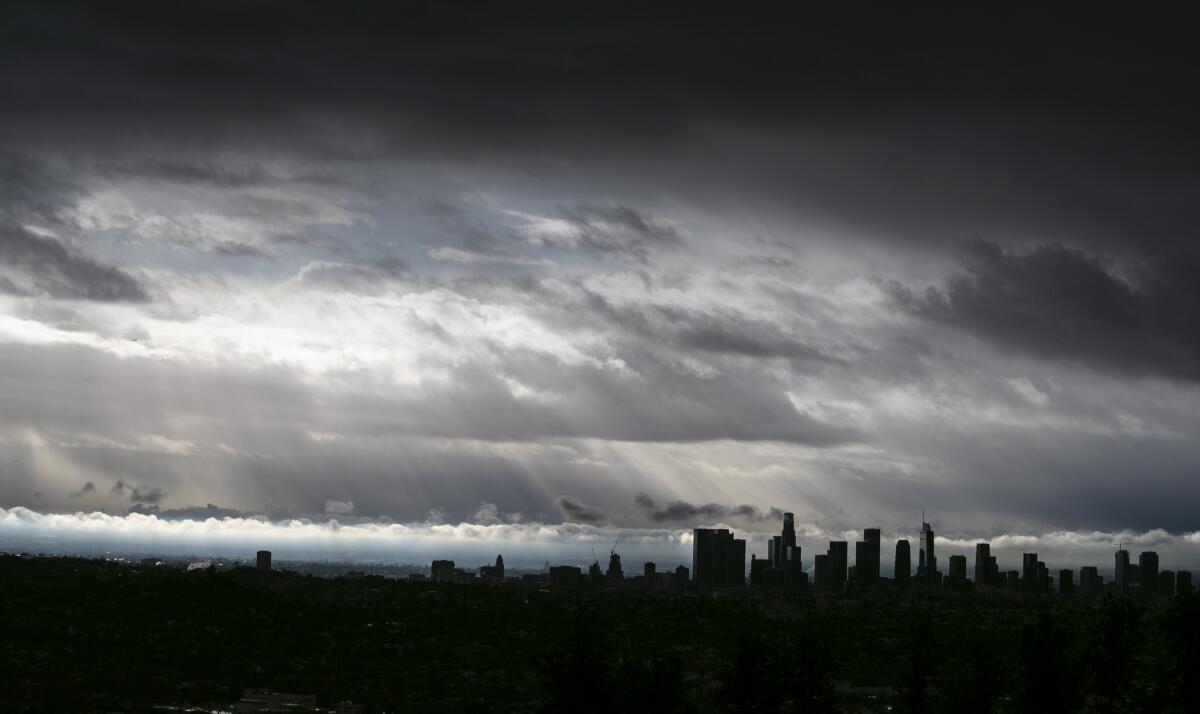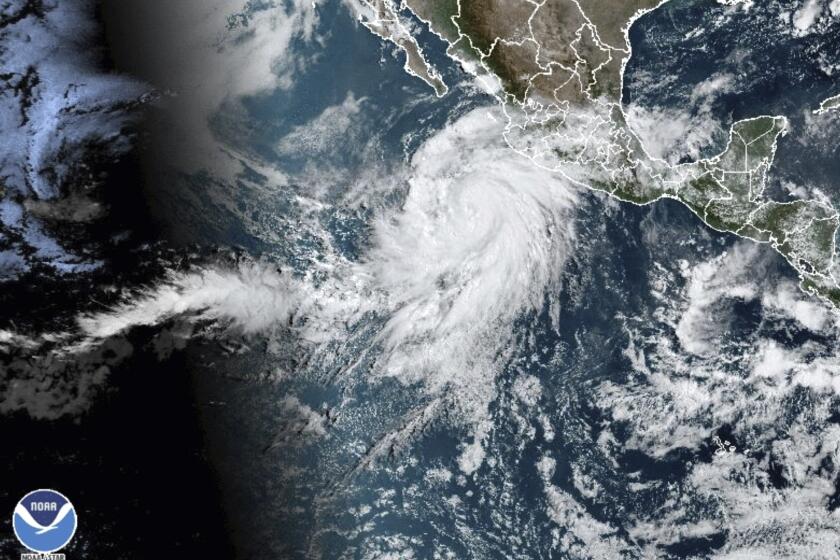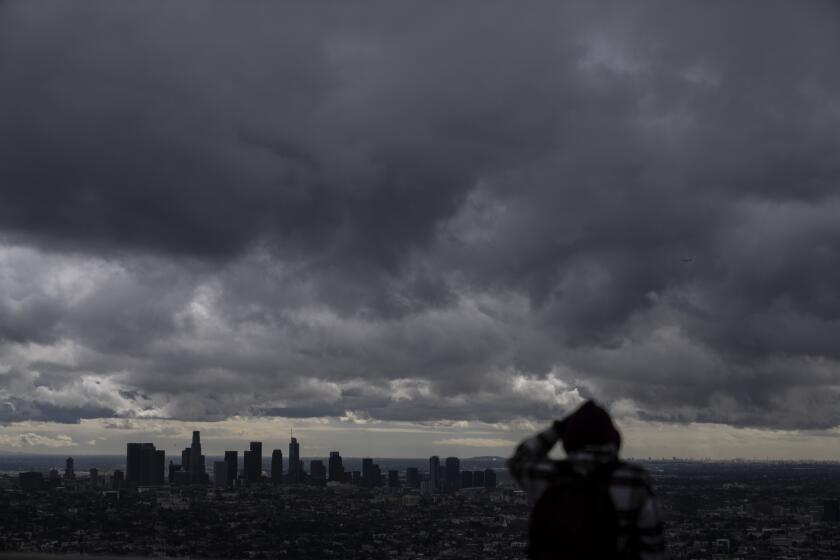How to prepare for Hurricane Hilary, the first tropical storm to hit L.A. in 84 years

- Share via
L.A. just got its first-ever tropical storm watch. That means tropical storm conditions are possible in the next 48 hours.
Hilary is currently a category 4 hurricane, but weather forecasters predict it will diminish to a tropical storm by the time it touches down here. A high-risk warning for excessive rainfall has been issued for areas across Southern California.
Expect to see 3 to 6 inches of rain around parts of Southern California and southern Nevada — up to 10 inches in some areas, according to the National Hurricane Center. There is also a high probability of flash flooding on Sunday and Monday: “Rare and dangerous flooding will be possible,” a spokesperson for the center said. That also means a risk of landslides, particularly in areas that have been impacted by wildfires.
The Los Angeles County Sheriff’s Department is working with the county’s Office of Emergency Management and other agencies in preparation for the storm, Sheriff Robert Luna said at a news conference. The department’s search and rescue, swift-water rescue, and rescue aircraft have been placed on alert, he said, and the department plans to deploy additional personnel on patrol starting Sunday, when the bulk of the storm’s force is expected to reach the county.
“It’s been 84 years since [a hurricane] came ashore, so it’s a once-in-a-lifetime event,” said Los Angeles County Supervisor Janice Hahn. “This is really an all-hands on deck effort.”
Here’s what that means for you: It’s time to prepare.
Though we typically don’t see a lot of summer storms, girding for Hilary is not going to look too different from getting ready for winter rain. You’ll want to sign up for alerts, charge your devices, make sure you’ve got some food and a few electricity-free ways to entertain yourself on hand, and make a plan in case of power outages, flooding or evacuations. Once the rain gets here, the safest thing you can do is hunker down at home, ready to heed evacuation orders immediately if needed.
Here’s what you can do now to prepare, and how to stay safe when the storm arrives.
Although Hurricane Hilary may not be as strong when it reaches California, it is still expected to drop a considerable amount of rain on the region.
How to prepare before the storm
While the skies are still clear, it’s time to get ready so that you can safely ride out the storm when it hits. Heavy rain, flooded streets and power outages are all possible, so you want to prepare as if you’re going to be staying at home for a few days.
Sign up for alerts and check often for updates. Sign up to receive alerts about emergencies. For the city of Los Angeles, sign up at Notify L.A. If you’re elsewhere in L.A. County, you can find your municipality’s alert system sign-up at the Ready LA County website. For other places, search “emergency alerts (your city or county).”
To get the latest information, you can listen to the weather radio livestreams from the National Oceanic and Atmospheric Administration at any time online.
To stay up to date in case of potential power outages, sign up for alerts from your electricity provider and bookmark its online map of outages. In a lot of Southern California, the provider is going to be Southern California Edison, which has an outage map and lets you sign up for alerts by email, text and phone. In the city of Los Angeles, you can check the L.A. Department of Water and Power outage map and, if you have an account with the DWP, sign up online for alerts. San Diego Gas & Electric’s website also offers an outage map online and instructions on how to download its app with alerts. And Pacific Gas & Electric, which serves much of the rest of California, has an outage map too, along with a way to sign up for alerts.
Make a plan. How will you communicate with family members in other parts of the city or state? Do you have crucial phone numbers (family, co-workers, doctor’s office, pharmacy) written down somewhere in case your smartphone battery dies? Do you have supplies to care for pets, young children and people in your household with special medical needs? Where will you go if you need to evacuate?
Tropical Storm Hilary threatens heavy rains, flash flooding, high winds and intense surf across Southern California this weekend. Here’s what to expect.
Check your emergency kit. Is your emergency kit ready to go? Do you have food, water and flashlight batteries? Enough medication, pet food, formula and diapers to last a few days? Hard-soled shoes, work gloves, goggles, duct tape, a first aid kit and heavy garbage bags? What about a fire extinguisher, cash and a hand-crank weather radio? Here’s the full list of things that should be in your emergency kit.
Prepare as if the power might go out. Here is a complete list of what to do before, during and after a blackout. The short version: Charge your devices, including phones, laptops, and portable power banks. Put a flashlight, a pair of hard-soled shoes and a pair of eyeglasses by your bed. Fill up your car’s gas tank or charge its battery. Check the batteries in your smoke detector and carbon monoxide detector. Brainstorm a few meals you can throw together with what you have on hand that won’t require you to open your fridge or freezer. Break out a puzzle, board game or craft project.
Get your house ready for potential floods. Clear your gutters and make sure there’s no debris near your storm drains or other drainage areas on and around your property. Consider bringing in or tying down lawn furniture, grills and trash cans. You might even consider moving valuables from the ground floor to an upper story of your home.
Some municipalities are giving out sandbags at fire stations and other locations. Call your local fire station or city government, or check their website or X (formerly Twitter) account to find out if they’re available in your area.
Learn who to talk to in government when you want to get things done in your neighborhood. Get involved in your L.A. County community with the help of our people’s guide to power.
What to do during the storm and potential flooding
Heed evacuation orders. If you’re told to evacuate, go. Here’s what to pack for an evacuation.
If you’re not told to evacuate, stay home. The safest place to be during a storm is in your home. Don’t make any trips beyond what’s absolutely necessary.
If you go out, bring supplies and exercise caution. If you venture out in your car, bring extra food, water, a phone charger and a first aid kit, along with enough clothing and blankets to stay warm.
Avoid flooded sidewalks and roadways. The weather service has a saying for what to do when you see a flooded street or road: Turn around, don’t drown. It’s hard to know how deep the water might be just by looking at it, and you can’t tell what the condition of the road is under the water. Just 6 inches of moving water can take down an adult or reach the bottom of a car and cause a loss of control and stalling. Two feet of water can sweep a vehicle off the road (and yes, that includes your hulking SUV or pickup truck).
Heat, light, charge and cook at home safely. Don’t use a grill indoors, don’t run a generator indoors, and if you use your gasoline-powered car to charge your phone or another device, make sure you have adequate ventilation. If you need lights, use flashlights or other battery-operated sources, not candles.
If your house floods, go up, not out. If water starts to rise in your home before you can evacuate safely, get to higher ground — an upper floor or the roof, if necessary — and wait for emergency responders. Do not attempt to swim to safety.
An unprecedented tropical storm watch has been issued for Southern California as Hilary barrels north toward the United States.
What to do after the storm is over
Don’t touch downed power lines.
Check in with family and neighbors.
Assess damage. Check to make sure your home and yard are free of debris and water damage. Call 311 for nonemergency services.
Stay safe on the road. Even after the rain is over, streets could still be flooded or closed by downed trees and other debris. Leave extra time to reach your destination and heed all road closures. Do not enter flooded roadways — even six inches of water can be deadly.
Use caution before hitting the beach. Parking lots and walkways near the water may flood. Ocean water may also be contaminated with unsafe levels of bacteria after the storm.
Replace any items you used from your emergency kit. Make sure you’re ready for next time. We have a newsletter called Unshaken about how to get ready for an earthquake or other disaster in just a few easy steps.
Hurricane Hilary is moving toward Southern California. Here’s how to prepare and stay safe before and during the storm, heavy rain and potential flooding.
More to Read
About this article
Sign up for Essential California
The most important California stories and recommendations in your inbox every morning.
You may occasionally receive promotional content from the Los Angeles Times.












